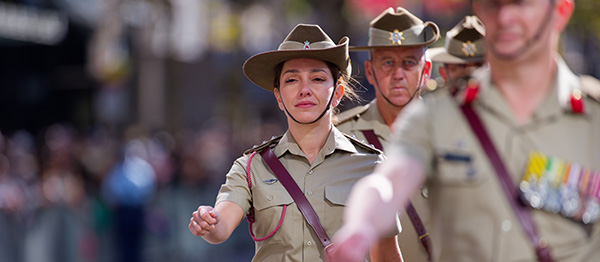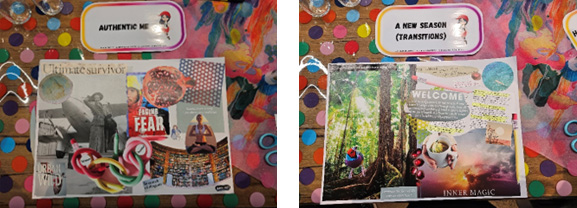HAT and Creative Engagement Strategies for Veterans
25/06/2024
Jennifer Barfield has over 15 years of experience guiding individuals through transformative career transitions and strengthening wellbeing. She is a Veterans Transition Specialist, utilising Hope Action Theory with creative engagement strategies to empower individuals and teams to take tangible steps.

When veterans are considering and/or transitioning from the Australian Defence Force (ADF) (whether voluntarily or not), finding a different career path may present its own unique challenges, including loss of culture and community, loss of identity and loss of purpose. Hope is essential for the career development process. Afterall, if clients don’t have a sense of hope how can we expect them to actively engage in career development activities/interventions?
Hope Action Theory (HAT) places action-oriented hope at the centre of the individual’s career journey as a necessary function of behaviour change, and sustainable lifelong career development. HAT is relevant to everyone who needs to make a career move or change. It is especially useful for those who need to find a pathway outside of a traditional or unique work history.
Self-reflection is one of the more unique aspects of the theory, and it is questionable how many people, including military considering or in the career transition process, engage in this proactively on a regular basis, pre-transition and beyond. Self-reflection is a subtle yet significant component of HAT, with self-clarity occurring as people develop answers to self-reflective questions.
It is interesting to note that as Spencer Niles has previously pointed out, “each of HAT’s competencies represents a component of decision making. Therefore, one perspective is that HAT deconstructs the career decision-making process”. (Amundson, Niles, & Fruhling, 2021)
Visioning ties in with imagination, and the need to stretch imagination. For a lot of people, as they lose hope, their imagination gets constricted, and it is harder for them to imagine themselves going forward, “what are they going to do etc”– this is particularly relevant for veterans who are involuntary medical or administrative transitions and who have not had time to ‘plan for their transition’ – Norm Amundson (Amundson, Niles, & Fruhling, 2021)
Over the previous 12 months, my work with military personnel has focussed on those in various stages of transitioning from regular ADF service. All of who had already engaged in job search preparation workshops including resume writing, and ‘job matching’ to ADF roles activities, and by the time they met with me, were asking themselves the following questions:
- ‘Who am I beyond the uniform?’
- ‘Where to next?’
- ‘Am I employable?’
- ‘Is it too late for me? / Am I too old to transition to a civvy job?’ (the person was 45 years old at the time)
Without gaining self-reflection and self-clarity, before engaging in job search activities, what impact may this have on the sustainability of their lifelong career development?
Creative engagement strategies supporting HAT competencies
At the Australian National Veterans Arts Museum (ANVAM) March to Art: Form 2024 launch, Mr Kahlil Fegan DSC, AM, the Repatriation Commissioner (Australian Government Department of Veterans Affair), spoke of how he had witnessed the transformative power of the arts by ADF members, to inspire moments of hope and togetherness whilst serving in various conflict regions. As the ADF veteran artists community continues to gain traction and recognition, we can also embrace creative engagement strategies to support this diverse group.
A creative engagement approach helps to empower clients by unlocking their unconscious through blending of rationality and emotion to develop self-clarity. When head and heart work in tandem, feelings are validated encompassing the whole brain. “Whole brain approach to creativity using imagination, intuition and critical reflection enable coaches to be innovative, but also enabling clients to discover their creative potential to solve their own problems” (Hambly & Bomford, 2019, p. viii).
In Norm Amundson’s anniversary edition of his book ‘Active Engagement: The Being and Doing of Career Counselling’, he describes how as a supervisor of counsellor trainees, he encouraged students to be more creative and active in their counselling sessions by using techniques involving “metaphors, drawings, in-depth exploration techniques, writing and poetry, storytelling, solution-focused questions, behavioural rehearsal” etc (Amundson N. E., 2021, p. 3).
Below are examples of some creative engagement strategies, there are many more.
| 'My Life as a Book' |
|
Stepping Stones |
|
Metaphor Map |
| 'Career Maps' |
|
River Flow |
|
Scaling Questions |
| Mindfulness Practices |
|
Lego Serious Play+ |
|
'My Plan' |
| Motivational Interviewing |
|
Walk the Problem / Vantage Points |
|
Brainstorm Future Possibilities Visually |
| Whole-Brain Decision Making |
|
Liminality |
|
Poetry / Art Work |
| Scenario Thinking |
|
Collage Coaching TechniqueTM (CCT) |
|
Music |
| Metaphors |
|
Photos of What Jobs / Careers Look Like to Client |
|
Soul Places / Soul Teachers |
* Metaphor map created by Andrea Fruhling, available from Doubleknot Works website
+ Lego serious play is an example only – other resources could be used
Metaphors and analogies are a “powerful mechanism for burrowing deep into the part of the brain where limiting beliefs and habitual thinking lies and can unearth fresh perspectives and ways of being” (Stalker & Hambly, 2023, p. 8). The following metaphors are examples of how ADF members in career transition described their situations during client sessions, mostly as part of the Jobs Victoria Career Counselling Service (JVCCS).
| |
Metaphor Used |
|
Situation |
| |
Last roll of the dice |
|
Last try for promotion before initiating career change |
| |
Feeling like I’m at the crossroads |
|
- Awaiting medical decision that will determine future options
- Career indecision
|
| |
Between a rock and a hard place |
|
Awaiting medical decision that will determine future options |
| |
(Not) interested in climbing up the career ladder |
|
Transitioning career, considering future semi-retirement. More concerned about work-life balance |
| |
Duck swimming gently on the surface, but madly paddling underneath |
|
Competing tasks at work, feeling like “just” coping with overload at work |
| |
Turning lost in a fog |
|
Career decision making – what other options are available? Which direction to take |
| |
Knocked the wind out of my sails |
|
News of unexpected / unplanned career transition |
| |
Path of least resistance |
|
Should they accept the safe / easy option even if it doesn’t align with values and future vision? |
| |
14 years of service was like being in a chrysalis |
|
Felt protected from the ‘outside world’, but also kept in the dark, by not knowing what the outside world was like in terms of workplace cultures, job role similarities between ADF and civilian comparable roles (HR Management) etc |
By “expanding their metaphor”, it provided insight into emotions, and how the client was conceptualising the situation. Andrea Fruhling’s metaphor map is a handy tool to gauge how the client is feeling and what is going on in their world for example, at that moment in time.
Case Study:
Ray, a senior non-commissioned officer, was facing a potential medical transition, dependant on the outcome of future surgery. During their initial client session, they said they felt ‘lost’ when they first engaged with another career guidance service. Ray had been unable to identify options for how their military service could be utilised in civilian opportunities. They explained that they felt like they were at a crossroads, unsure of what path to follow. Ray also said that they were terrified that the only vision they had after transition was ending up sitting in a local RSL ‘drowning their sorrows’.
Together, we unpacked their use of the crossroads metaphor, and over three sessions, using creative engagement strategies stepping stones, river flow (identify something you are proud of) amongst others, a ‘two pronged’ approach to career exploration was developed based on the two possible scenarios after the outcome of the planned surgery. This approach gave Ray action-oriented hope. Ray’s feedback was: “I can now see what you have been helping me to see – that there are other options, and how I can use my military roles and experiences in different ways. I now feel like there is hope for a brighter future.

Andréa Watts, the creator of Collage Coaching Technique™ (CCT) explains that the technique although “based on the principles of art therapy and the work of Carl Jung, draws heavily on other disciplines and influences that interconnect throughout the process” (Watts, 2023, p. 3). These include amongst others, the use of metaphors, mindfulness, creativity, storytelling. CCT is a powerful technique for empowering clients to become unstuck.
I witnessed this first hand, when I facilitated a coaching with collage workshop for veterans and the veteran community at the inaugural Festival of Veterans Arts (FOVA) in February, organised by ANVAM.

Benefits of CCT enriching client experience as outlined by Watts on page 4 include:
- Accessing unconscious thinking
- Connecting emotionally with goals
- Non-threatening method
- Quickly uncovers emotional drivers
- Sense of wellbeing
- Tangible output
- Experiential technique
It has to be pointed out, that as part of CICA’s ethical standards, the career development practitioner needs to be cognisant of remaining in their lane and referring the client to other appropriate services if required.
Being self-directed and coming from our internal knowledge, CCT helps answer the questions:
- “Who am I?” without labels of job title, career or even family.
- “What do I believe, care about, feel, think?” etc
- “How does this inform my choices, decisions, relationships and how I show up in the world?”
As Andréa Watts mentioned in a discussion we had in 2023 about the benefits of using CCT with veterans and members of the veteran community in career decision making, “CCT allows a depth of exploration and reflection as you return to the images to ask and learn more, gain insights and deeper self-awareness. Using images bypasses what can get in the way, the editing, self-conscious, fear, ego etc”
As visuals are processed faster than text, with 90% of information to the brain being visual, a whole-brain decision making approach taps into all of the senses to access both the intuitive and rational process. It is encouraging to see how HAT combined with creative engagement intervention strategies, can support career changers to identify and pursue new career goals with increased confidence and motivation.
*Names, and personal details changed to maintain client confidentiality. Client permission given for use of images
References
Amundson, N. E. (2021). Active Engagement Anniversary Edition: The Being and Doing of Career Counselling. Doubleknot Works.
Amundson, N., Niles, S., & Fruhling, A. (2021). Advance Hope Action Theory Practitioner Course. DoubleKnot Works.
Hambly, L., & Bomford, C. (2019). Creative Career Coaching: Theory Into Practice (1st ed.). Abingdon, Oxon, United Kingdom: Routledge.
Stalker, L., & Hambly, L. (2023). Sailplaning: Creating a 4-D Life & Career. Sailplaning Publishing.
Watts, A. (2023). Collage as a Creative Coaching Tool. Abingdon: Routledge.